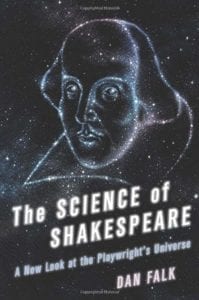
Shakespeare’s audience did not have to look far to see the stars: A wooden canopy projected out over the stage, and its underside—known as “the heavens,” was decorated with brightly painted stars and constellations. It served its purpose in Hamlet, for example, when the prince refers to “this brave o’erhanging firmament, this majestical roof fretted with golden fire” (2.2.283-5) or when Caesar declares that “the skies are painted with unnumbered sparks” (Julius Caesar 3.1.63).
The view of the universe engendered by this simple theatrical device wasn’t so far off from how our ancestors had envisioned the cosmos for thousands of years: We look up at night, and we see an uncountable number of stars, brilliant pinpoints of light, seemingly painted on the vast dark canvas of the night sky. And back then, before the light pollution brought by electrical lighting, the sky really was black. In Antony and Cleopatra, when Lepidus says to Caesar, “Let all the number of the stars give light/To thy fair way!,” we might imagine that the stars truly shone brightly enough for the purpose (3.2.65-66). (In practice, a bit of moonlight would probably help.) The stars were intimately familiar, yet at the same time deeply mysterious. They were certainly far away—climbing the highest hills did not seem to bring them any closer—but how far away, one couldn’t say. Perhaps they lay just out of reach; a little farther, perhaps, than the great oceans or the highest mountain peaks.
The sun was more familiar, its presence more intimate: the brightest of lights; the giver of life. Everyone knew that it rose in the east and set in the west, but they also knew the subtle variation in that pattern over the course of a year: In the winter, the sun makes only a low arc across the southern sky, while summer brings longer days in which the sun takes a much higher path across the sky. The cycle repeats, with perfect dependability, year after year. A farmer had to know the sun’s movement—but so, too, did a playwright; for the action to be visible, one had to content with the harsh sunlight of midsummer as well as the long shadows of autumn and the all-too-early darkness of the winter months. Sophisticated stagecraft and spectacular costumes mean nothing if audience members have to squint to see them. As Peter Ackroyd writes, Shakespeare was “aware of the passage of time and of daylight across the open stage, so that he wrote shadowy scenes for the hour when the shadows begin to deepen across London itself.” Stage directions calling for a character to enter “with a torch” or “with a light” tend to come in a play’s final act. (There is also some evidence that the Globe was constructed in alignment with the position of the rising sun on the summer solstice.) Of course, one might misread a signal: In Romeo and Juliet, the two lovers famously quibble over the signs of the coming dawn. A bird cries—but was it the lark, or the nightingale? “Night’s candles are burnt out,” Romeo declares, “and jocund day/Stands tiptoe on the misty mountain tops.” Juliet has heard and seen the same signals, but her wishful thinking interprets them quite differently: “Yon light is not day-light, I know it, I: / It is some meteor that the sun exhales.” (The physics of meteors was not yet understood; a common guess was that they were vapors “exhaled” by the earth under the sun’s influence.) Eventually, Romeo gives in: if Juliet says it is night, so be it:
I’ll say yon grey is not the morning’s eye,
‘Tis but the pale reflex of Cynthia’s brow.
Nor that is not the lark whose notes do beat
The vaulty heaven so high above our heads.
(3.5.19-22)
From The Science of Shakespeare: A New Look at the Playwright’s Universe by Dan Falk, Thomas Dunne Books, thomasdunnebooks.com. Reprinted with permission. All rights reserved.
